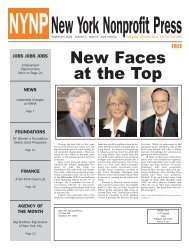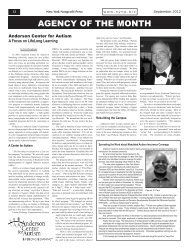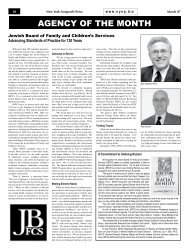February Edition 2007 - New York Nonprofit Press
February Edition 2007 - New York Nonprofit Press
February Edition 2007 - New York Nonprofit Press
Create successful ePaper yourself
Turn your PDF publications into a flip-book with our unique Google optimized e-Paper software.
10 <strong>New</strong> <strong>York</strong> <strong>Nonprofit</strong> <strong>Press</strong> www.nynp.biz <strong>February</strong> 07THE COMEBACKThe Comeback at St. Christopher’sRebuilding a Program and a ReputationThey didn’t have a chance. That was theconsensus outlook for St. Christopher’s Inc. inDobbs Ferry on January 14, 2005 when <strong>New</strong><strong>York</strong> City’s Administration for Children’s Servicesannounced that it was canceling $86 millionworth of contracts. Lost in one fell swoopwere the agency’s entire foster boarding home(FBH) program, 90% of its residential placements,preventive services, a citywide homemakerprogram and two child care centers. TheACS move came in response to a Departmentof Investigation finding that staff at St. Christopher’sFBH program had falsified case recordsin advance of an annual ACS review. No onein the broader child welfare community -- andI mean no one -- believed the 124-year-old St.Christopher’s would live to see its 125th birthday.Today, two years later, St. Christopher’sis thriving. It is certainly smaller. Thereare no ACS contracts; no FBH, preventive orchildcare programs. Yet, the agency is operatingnear capacity at both its Dobbs Ferry andValhalla campuses. It has a brand new schoolon campus and a 160-student special educationThe Kenneth Clark Academy, St. Christopher’s new on-campus school, opened in September 2005.day school in Yonkers. It has new leadership,new programs and an entirely new client base.Most importantly, it has a renewed and growingreputation for providing high quality residentialand educational services for particularlytroubled youth.St. Christopher’s turnaround may wellhave begun on March 14th of 2005 when theboard appointed Joseph Semidei to succeedLuis Medina as the agency’s new executive director.Once again, many in the child welfareworld were skeptical. Semidei has had a longcareer with City, State and Federal agencies buthad never headed up a nonprofit provider, letalone one facing imminent extinction. “Joe is abig picture guy, not a detail guy,” said one longtimecolleague. “And residential child care isall about the details.”Nevertheless, Semidei has guided St.Christopher’s through a stunning turnaroundand he has done it through both broad visionand attention to detail.“You have accomplished the most magnificentand wonderful transformation that I haveever seen in the child welfare field,” said RobertMcMahon, Executive Director of SCO Familyof Services, last April. “Your cottages are wonderfuland your school is just outstanding.”“This is a turnaround at an agency that weare very, very pleased with,” says Larry Brown,Executive Deputy Commissioner at the <strong>New</strong><strong>York</strong> State Office of Children and Family Services.“I have been very impressed with theflexibility and support of the board, the consistencyof the direction they are headed and theimprovements they have made. They have doneevery single thing we have asked them to do.”Getting from there to here has not beeneasy.Semidei’s first task upon taking up thechallenge was to get a true assessment of St.Christopher’s weaknesses and its remainingstrengths. Despite ACS’ across-the-board cancellationof City contracts, the DOI investigationhad focused on falsification of records inonly one particular program – FBH. “No otherprograms were implicated,” says Semidei whocontinues to believe that the agency-wide punishmentmeted out by ACS Commissioner JohnMattingly was excessively harsh. Nevertheless,Semidei sought out objective evaluationsof service quality at St. Christopher’s remainingresidential programs. What he learned wasnot reassuring.“The first week I was here I went to the regionaloffice of OCFS and they gave me an incredibleassessment of how extensive the problemswere,” recalls Semidei. “The first bulletpoint was all I needed to see. ‘No programstructure; no activities for the kids.’ I got mad.If the kids are not getting what they are entitledto, that pisses me off. It is unacceptable.”This and other assessments would go intogreater detail but there was a common theme.“The mantra of all auditing bodies consisted ofthree things: lousy progress notes, lousy treatmentplans and we don’t know what outcomesyou are achieving with these kids,” says Semidei.When he looked around, Semidei didn’tlike what he saw. The new campus school,in the planning stage for five years, was justa hole in the ground. The residential cottageswere dark, dank and covered with graffiti.Kids looked out at the world through sheets ofscratched and clouded Plexiglas. “You wouldsee a tremendous amount of anger visible onthe faces of children and staff,” says MuhammadRiaz, St. Christopher’s Director of ResidentialServices. “When people feel they arenot accomplishing anything, they are angry.”The new executive director set out tochange practice and culture across the agency.His first task was to establish a new “moralcenter”. “My experience with reform in thepast has always shown that a leader has to setthe moral direction,” says Semidei. “He has tohave high expectations for how you deliver servicesand how you treat the customer.” Semideiused what he called his “Five Cs”: Compassion,Conviction, Commitment, Creativity andCourage.Semidei also asked his program staff toanswer a simple, yet fundamental question: “Ifa child is here for one year, what is the benefitfor that child and that family? What uniquecontribution did we make? Why are we in business?”The result was a commitment to move ina new direction, away from the agency’s traditional“behavioral” model of programmingto a “clinical” modelwhich focused on meeting thespecific emotional needs of individualchildren. The agency’sstaff would expect more of andfor the children and themselves.Education would be at the core ofSt. Christopher’s program.Dr. Robert Maher, Superintendentof St. Christopher’s oncampusspecial act school, hasbeen a full partner in establishingthe agency’s new program. Mahercame to the agency in August2004 and began fixing problems.He resolved a longstandingdispute between the agency andthe State Department of Educationwhich had frozen reimbursementrates since 1997. “Theyhad actually had a decent program,but when rates werefrozen, they started cutting back,” says Maher.“The programs they cut were sports and co-curricula,things the kids related to most.”“Every child needs to be moving towards aRegents diploma,” Maher continues. “Not everychild will earn one, but that is the minimum goalwe should shoot for.” Maheralso wanted to round out theprogram. “We also wantedarts, music, dance, drama,drivers education, sports, allthe things that kids in regularhigh schools have.”At the new St. Christopher’skids would learn realscience and math from realteachers in spotless, graffiti-freeclassrooms. Theywould wear uniforms of brightly colored poloshirts over khaki slacks. “The kids balked at theuniforms,” says Semidei. “‘What is this, a prepschool?’ they asked. Yes. It is a prep school forpoor kids. We are preparing these kids for lifeoutside of poverty.”Armed with this new programmatic andeducational vision, Semidei and Maher neededonly two m ore things—money to implementthe plan and children to serve.With the loss of its ACS contracts, St.Christopher’s referrals had dropped by 90%.The agency was broke and almost empty.And, the situation would get worse before itgot better. In July 2005, Westchester County,its second largest customer, chose not to renewits contracts. The decision followed an incidentin which St. Christopher’s released a childfor a weekend visit with his uncle, a Level IIIsex offender. “We screwed up,” acknowledgesSemidei.The situation, which had been bleak, nowlooked dire. “Irreparable damage” was howFrank Spain, who had guided St. Christopher’sthrough its initial response to the ACS scandal,described the blow.“This was not the kind of situation youcould handle through the usual belt-tightening,”says Semidei. The agency had alreadylaid off 150 staff in its FBH and other ACS programs.St. Christopher’s needed new customersand it needed them right away.Amazingly, an entirely new customerbase was ready and waiting. For decades, thestate and local governments – particularly localschool districts – had been sending their mosttroubled children out of state to institutions thatwere prepared to accommodate their specialneeds. These “out of state placements” havebeen extraordinarily expensive in both financialand human terms. Unrestricted by <strong>New</strong> <strong>York</strong>’sown rate setting guidelines, these institutionshave been able to charge whatever the marketwould bear. And, localities with nowhere elseto turn were prepared to pay heavily. At thesame time, facilities in Pennsylvania, Connecticutand even Florida are a long way away,both from a child’s family in <strong>New</strong> <strong>York</strong> andfrom regulators expected to monitor their care.It has often been argued that some of these institutionsare better at marketing their servicesthan actually providing them.Consequently, over the same period oftime, officials at all levels of government havebeen calling for these children to be broughthome. These efforts took on a new urgencyin July of 2005 when the State Department ofEducation was assigned responsibility for developinglocal placement options. However,local providers, bound by the State’s tighterreimbursement guidelines, have been reluctantto take up the challenge.St. Christopher’s no longer could affordSt. Chrisopther’s invested over $700,000 in the renovation of its residentialcottages.to say no. “We made a virtue out of necessity,”says Semidei. The agency set out to becomethe placement of choice for children referredby local Committees on Special Educationwho would otherwise be headed out of state.











